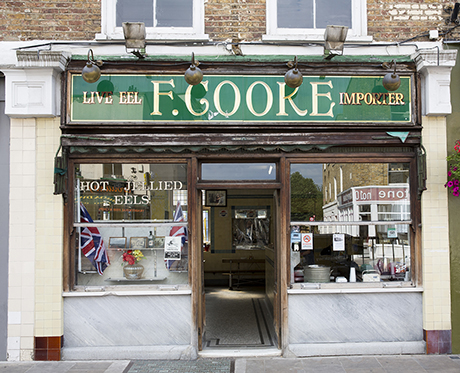Keep it eel: East End’s original jelly snack
When Judith Leyster painted a portrait of two of her offspring they were depicted playing rather wilfully with a wriggling eel and a fractious kitten, both of which might have symbolised the untameable primal urges of feral small children.
The eel was one of the cheapest commonplace foods in 17th century Holland; even during the bitter maritime wars with England the bilges of ships of both nations were teeming with eels, a useful commodity.
Today they have become an expensive luxury, and smoked eel in a brodje, something I reach for with a slug of genever whenever I arrive at The Hague, is now a treat, not a cheap filler.
Most of the eels consumed in our eel and pie shops are farmed in the Netherlands; not for them the long journey from the Sargasso Sea to the rivers and lakes of Europe where they feed and grow and flourish, and then the long 4,000 mile trek back, to breed spawn and then, worn out, die.
The gastronomic reputation of eels is a sort of snakes and ladders story. They slither from delicate luxury to cheap food for the poor, then back again with recipes for both eventualities.
The eel recipes of renowned 17th century cook Robert May were delicious and varied, including a dish where the eels braised with wine and water, flavoured with an anchovy and some oyster liquor, crushed mace and cloves, salt and pepper, with chopped spinach, parsley, and sorrel, and a little onion, and served in their rich juices, thickened with beaten egg yolks and butter, decorated with slices of lemon. They could be stewed with herbs, or cut into lengths and fixed on skewers with bay and sage leaves, and grilled before a coal fire.
About a decade ago eel and pie shops used to display tanks of live eels just before Christmas, when mainly Italian customers would stand in line for the main ingredient of the traditional Christmas Eve speciality – a stew of eels cooked in olive oil, white wine, garlic, rosemary and a slug of grappa. This was a non-meat meal, following religious usage.
Our own London versions today seem rather pallid, the ‘liquor’ for hot eels used to be their cooking water flavoured with chopped parsley and allspice berries, until the Health Police raised its ugly head and ordained that the liquor served as a gravy with both eels and pies, might be allergic for pie eaters who can’t face eels (imagine!).
Now it is just a sort of white sauce with parsley, thickened with flour and butter. Our jellied eels are similarly bland, in a clear jelly. Some supermarkets buy them wholesale from purveyors of frozen fish, ready cooked, in tubs. You can also buy frozen eel portions, a good way to try out historic recipes.
So eels are moving on, in their journey to and from the Sargasso Sea, from luxury to cheap fodder to smart retro food.
Around 1914, when the eel and pie shops were flourishing, the bumper edition of Mrs Beeton’s Household Management, which gives the cost of recipes, indicated that eel were nowhere near as cheap as herrings or cod, but similar to sole and red mullet. Not dirt cheap. The eel and pie establishments, many of them founded in the early 1900s, were offering reasonably priced wholesome comfort food, in unthreatening surroundings, to customers who may not have had the luxury of a comfortable warm kitchen of their own. The friendly welcoming fug of a flourishing eel and pie shop was a refuge from hard times and bleak weather.
F. Cooke had a beauty, in Kingsland Road opposite Ridley Road market. I used to stagger there with my heavy shopping bags and runny nose, enjoying the warmth and the sense that this quintessentially Hackney eating place would outlive me and be around forever. It is now a popular Dim Sum joint – Shanghai.
But many others are flourishing nonetheless, like the branch of Cooke’s, in Broadway Market (pictured), where eels come already cooked and in their jelly from Holland via Billingsgate Fish Market.
Kelly’s in Roman Road offers kindness and a warm welcome as well as home made pies and freshly cooked eels. There are several shops run by the Manze and Cooke families and many more all over South and East London.
The interiors of these cherished establishments, which have survived changes in fashion and new trends in street food, now seem strangely familiar. The distressed white tiles, battered wooden booths, marble-topped tables and obsolete light fittings , the tiled floors, mirrors and pot plants, blackboard menus and down-market sauce bottles, are just as they always were. But meanwhile we queue up outside new-fangled eateries in central London whose decor seems to be trying just a little bit too hard compared with these genuine survivals.
But eels have a future. A company in Eltham supplies over 300 supermarkets with jellied eels, over 15,000 pots a week. Smoked eel fillets have become an expensive and trendy starter, for the salting and curing process deals with the sliminess that some of us dread, and the natural Omega oils add unctuousness as well as flavour to the fillets – a delicacy.
The charm of the surroundings and the honest quality of the food, in spite of the rise in price of eels, ensure a happy future for Hackney’s eel and pie shops.

